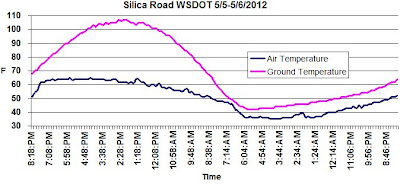Why are my seeds not germinating and rotting in the soil?
When will the soil be warm enough to sow my seeds or transplant my plants?
Well, I don't pretend to be an expert in this, but I suspect it has something to do so with the temperature of the soil.
 |
| You can purchase or adapt a thermometer for taking soil temperature measurements |
The first thing to keep in mind is that the temperatures you hear about on TV or read about in the newspaper are for the air temperature, in shade, at a height of roughly 2 meters (6 feet). So when meteorologists talk about surface air temperatures...that is what we mean. And such temperatures SHOULD be taken above native vegetation, which is increasingly rare.
Now the temperature of the ground surface is often quite different than the air temperature. During sunny days, ground temperatures can be much warmer than the air temperature (10-40F is not unusual), and on a cold, clear winter nights, when the ground radiates heat to space, the ground temperature can be 1-8F cooler than air temperature. After relatively warm periods, heat conduction from the warmed soil below can keep the surface temperature warmer than the air temperature at night.
Several of these characteristics are evident in this plot of surface and ground temperatures at the WSDOT road weather site at Silica Road (near Quincy in eastern Washington, along I90) for Sunday. Time advances to the left in this figure. The road temperature zoomed up to roughly 105F, while the air temperature was in the low to mid 60s! Wow. And last night the air temperature was cooler than ground temperature as the former dropped in the upper 30s.
 Such super-large temperatures changes just above road surfaces lead to the famous water on the road mirage (see my book for details on this).
Such super-large temperatures changes just above road surfaces lead to the famous water on the road mirage (see my book for details on this).Now what about the soil temperatures? The deeper you go into the soil the weaker the daily temperature variation becomes, with the soil temperature increasingly reflecting the average temperatures of the weeks and months before as one descends. Here an example of the soil temperatures at roughly 1 inch (2.4 cm), 6 inches (15 cm), and 12 inches (30 cm). Lots of daily variation in the top inch (in this case a range of 30F), but only a 2F range at 12 inches. And you can see it takes a while for the warming to propagate down into the soil. Go down 5 feet or so and the temperature hardly varies throughout the year.

So what are the current soil temperatures around the State? Lets look at soil temps at 8 inches down from the highly useful Washington State University AgweatherNet . Here are the values today...mid 50s over western Washington and the mid to upper 60s over the western portion of eastern Washington (60 and above are in yellow).
 Now lets examine the 8-inch deep soil temperatures in Seattle since January 1 (see graph). A steady rise until the cold spell this week, and now it is rising again with the warmer days. Roughly upper 50s F.
Now lets examine the 8-inch deep soil temperatures in Seattle since January 1 (see graph). A steady rise until the cold spell this week, and now it is rising again with the warmer days. Roughly upper 50s F.
Ok, so what does this have to do with the germination of vegetable seeds....and particularly why my bean seeds are just rotting in the soil?
Take a look at the typical soil temperature required for germination of various seeds (see below). Big variations. Here in western Washington we are now good to go for corn, spinach, carrots, and peas (not shown, but ok at 50F). But beans need soil temps in the 60s. Boy did I make a mistake planting those too early! Next time I will check the soil temperatures before I sow.
 Vegetables or not, soil and ground temperatures are fascinating, and during the winter knowledge about them can save your life when roadway icing is threatening.
Vegetables or not, soil and ground temperatures are fascinating, and during the winter knowledge about them can save your life when roadway icing is threatening.
Hiç yorum yok:
Yorum Gönder